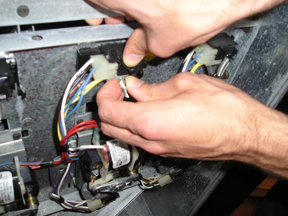
This page lists different home energy retrofits that can improve energy efficiency in standard US homes. Many people in the United States live in homes that were built in the last century. According to the EPA, homes built before the 20th century were generally more efficient.[1] There are many ways you can save money and energy in your home.[2]
Home energy audit[edit | edit source]
A home energy audit is a way in which you can actually look at what areas of your home you are using, and possibly losing energy. While you could always hire a professional to do this, we recommend you learn how to do this yourself and learn how to do it right.[3] It is your home we are talking about. Here are some useful resources to get going:
- DIY Home Energy Assessment (recommended)
- Home Energy Audits
- How to do an electrical energy audit
- Observational U.S. home energy assessment
- How to use a KillAWatt meter
- Phantom power reducing power bars
- Phantom power reduction (smart power bars)
- Phantom loads
Retrofits[edit | edit source]
Windows[edit | edit source]
Your windows may be one of the biggest contributing factors as to why your house is too cold in the winter and/or too hot in the summer.[4] There are many different things to try on your windows other than just buying new ones. Individuals might find some things more cost effective than others such as thermal curtains or film on your windows.[5]
Use these helpful tools:
Lighting[edit | edit source]
One of the simplest ways to save a copious amount of energy is switching your incandescent light bulb to LED lights.[6]
- CFL
- A Method for Cutting Bottles Light Bulbs and Fluorescent Tubes
- Fluorescent bulbs
- LED lighting
- Grid connection
- CCAT energy conservation
- Linear fluorescent retrofit (T12 to T8)
- Skylights
- Smart windows
- Solar charged flashlight
- Street lighting Analysis
- Heliostats
Water[edit | edit source]
The average US homes wastes thousands of gallons of water a year.[7][8] There are many things to know and ways to save, depending on your budget and how much you are willing to do.[9]
- 1.6 GPM or less low-flow shower heads
- Ultra low flush
- If it's yellow let it mellow
- Composting toilets
- Faucet Aerator
Insulation[edit | edit source]
Insulation can be a huge help in saving the energy that you are already using but that is being lost by not insulating your home well.
- House insulation
- Thermal insulation
- Building Insulation ECM
- US natural insulation comparison
- Cotton insulation
- Natural wool insulation
- VOCs in fiberglass insulation
- Cellulose insulation
- Ceiling insulation out of recycled Tetra pack at Pedregal
- Samoa Hostel Insulation Station
See also[edit | edit source]
- Wikipedia:Energy audit
- The Secret to Turning Consumers Green - Interesting article from the Wall Street Journal
Notes and references[edit | edit source]
- ↑ http://epa.gov/region5/sustainable/energyadvice.html
- ↑ Price, B., & Price, J. (1976). The Homeowner's Guide to Saving Energy. Blue Ridge Summit, Pa.: G/L Tab Books.
- ↑ Stephens, B., Carter, E., Gall, E., Earnest, C., Walsh, E., et al. (2011). Home energy-efficiency retrofits. Environmental Health Perspectives, 119(7), A283-a284.
- ↑ http://www.nfrc.org/documents/u-factor.pdf
- ↑ http://en.wikipedia.org/wiki/Window_insulation_film
- ↑ https://www.treehugger.com/most-energy-efficient-led-light-bulbs-5097108
- ↑ http://www.epa.gov/WaterSense/pubs/fixleak.html
- ↑ http://www.jetsongreen.com/2011/04/home-water-waste-info-graphic.html
- ↑ Save water, save energy. (2002). Professional Safety, 47(11), 45-45. Retrieved from http://ezproxy.humboldt.edu/login?url=http://search.proquest.com/docview/200389992?accountid=11532